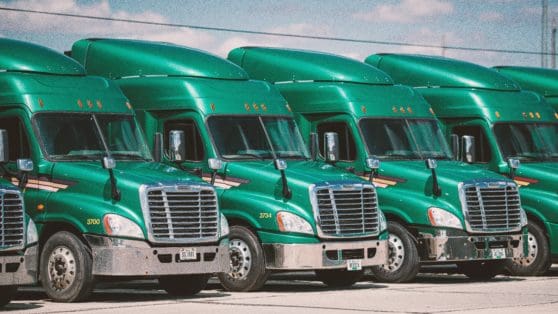If you’re a fleet manager or an owner, chances are you’ve already had to replace at least half of your drivers in the last 12 months, and you’re not alone. The annual driver turnover rate for truckload carriers rose to 92% in 2020. This shows that drivers across the country are frequently looking to change companies in search of better working conditions, making driver retention particularly difficult.
Whether it’s low pay, false or unrealistic expectations, dissatisfaction with their trucks or the lack of a safe and reliable work environment, truck drivers have many reasons to be on the lookout for new opportunities, according to a recent study by MDPI. If not kept in check, high turnover rates can have a seriously negative impact on your fleet.
Not only does it cost an average of $12,000 to replace a single driver, but the pool of available drivers you can find is shrinking. The high number of retiring drivers, lack of new drivers and COVID restrictions that led to shutting down training schools and testing facilities all make it harder to find eligible drivers you can depend on. That’s why increasing your driver retention is extremely important.
While increasing pay or offering better benefits are helpful, there’s much more to a successful driver retention strategy. “Trucking is a people business; drivers do not want to be treated like numbers,” says Max Farrell, CEO of WorkHound. “They are more likely to stay with companies that have the human touch and strive to create personal relationships with them.”
To keep your drivers satisfied and make sure they aren’t constantly looking for a better opportunity elsewhere, you’ll need to implement a solid driver retention program. Read on to discover 6 driver retention tips and strategies you can implement today to improve morale and avoid being short on drivers anytime soon.
1- Recognize positive driving
Yes, pointing out to your drivers where they’re making mistakes so they can avoid them in the future is important. But how would you feel if all your supervisor did was to constantly tell you about every little mistake you made on the job?
That’s why it’s also important to notice and celebrate the good performances.
Unfortunately, most fleet managers only focus on the negatives, partly because the telematics systems they rely on mainly highlight driving mistakes and negative metrics. So your first step towards making your drivers feel more at ease is doing what other managers aren’t doing: recognize positive driving.
To do that you’ll need a telematics system that helps you effectively measure good driving. Take Driveri® for example, an intelligent safety dash-cam system that uses AI analytics to reduce incidents, prevent false claims and more importantly, reward safe driver decision-making. It does that through GreenZone®, the first driver score built on positive driving.
Driveri® captures positive driving behavior like creating space for merging vehicles, then adds points to drivers’ GreenZone® score whenever a positive event occurs. This way both you and drivers get notifications when a they reach key milestones, which makes the task of recognizing positive driving easy and automated.
2- Reward top performers
Once you’re able to identify positive driving, you can start rewarding it to keep drivers engaged and motivated. By introducing gamification, you tap into one of the most basic human psychologies: the innate joy that comes from playing, competing and of course, winning. This helps build a better team spirit and safety culture, but more importantly, it shows your drivers that you value their efforts.
There are different ways you can reward your top performers so they can feel appreciated. Offer incentives to leaders in important safety metrics such as the number of consecutive collision-free days or the number of safe miles driven. Highlight winners in your weekly newsletter or on the company’s social media account and send them company swag so they can show off their safe driving skills.
While a reward system might cost you close to nothing, it can do wonders for your driver retention, because drivers, like all other employees, stay where they feel appreciated. Not to mention the impact it can have on your safety record.
3- Invest in proper training
Another effective way to retain drivers is to invest in them. But how does investing in your drivers look like?
For one, you can offer to pay for training and certifications that help them advance in their careers. You can stand out from others in the market by offering to pay for CDL training or issuing company laptops to drivers. This will not only help you retain your existing drivers but also attract new ones.
There are also free online training options your drivers might be interested in. You can recommend courses like the OSHA safety training and the DOT compliance basics that offer certifications. You can even compensate drivers that acquire these certifications to reward their dedication to safer driving.
4- Ask for their feedback
A sure-fire way to make drivers want to stay is by making them feel appreciated, and what better way to do that than to listen to what they have to say?
Many fleets overlook the importance of driver feedback. It can help you understand how drivers feel about culture or workflow-related issues on how you can improve. Not only is their feedback important for increasing driver retention, but it can also help improve operations.
So keep your door open and make sure to ask for their opinion and feedback regularly. You can even use free online tools to offer anonymous surveys that make it more likely for drivers to share their suggestions. Of course, the most crucial part is to act on the feedback you get. Let them know how you’re applying their feedback and highlight the impact of these changes to keep them engaged.
5- Offer Sufficient Pay
While good pay compensation might not be reason enough to make drivers want to stay, any successful driver retention strategy includes competitive pay. In fact, according to the 2020 Stay index, sufficient pay was cited as the top factor in driver retention for both men and women drivers.
So if you’re hoping to improve your driver retention rates, you’ll need to make sure they are well compensated. Look at increasing pay and benefits or at offering a different payment model such as paying by the hour vs. mileage pay. But before choosing, make sure you consult with your drivers to see what solution works best for them.
6- Prioritize driver safety and mental health
There is no question that the safety of the fleet depends heavily on the safety of the drivers and their mental health. There is plenty of evidence that proves poor mental health is directly related to an increase in the risk of driving accidents.
Even under normal circumstances, a trucker’s job is very demanding both physically and mentally, and the COVID pandemic did not make things any easier. With increased infection concern and social distancing requirements, feelings of loneliness and isolation can understandably increase.
It’s crucial to acknowledge safety and mental health challenges and to show your drivers that their safety and wellbeing are a top priority for your company. Work to increase awareness on these issues, offer the necessary support and encourage them to seek help whenever necessary.
Final Thoughts
With shortages in available drivers, high annual driver turnover and increasing demand for shipping, the need to retain drivers has never been greater. That’s why it’s vital to implement a strong driver retention strategy that makes drivers feel appreciated, safe and well-compensated. By implementing a quality telematics solution that allows you to celebrate positive driving and reward top performers, you can keep drivers engaged and motivated. Combine that with a solid feedback system, a well-rounded safety culture and competitive pay, and you might even start to attract new drivers to join your fleet.
Read the Guide to Driver Coaching to continue learning.







